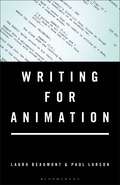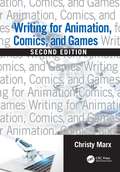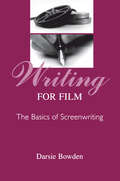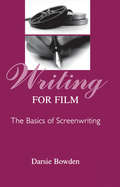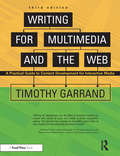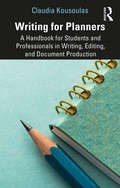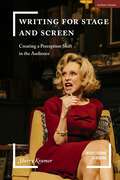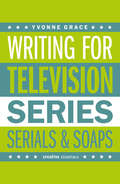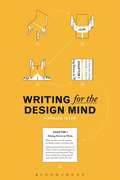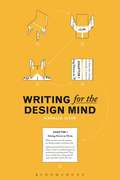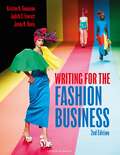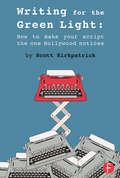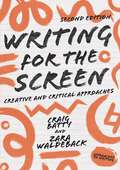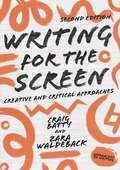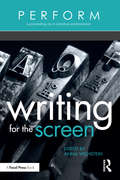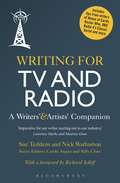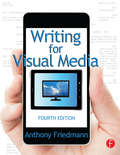- Table View
- List View
Writing for Animation
by Laura Beaumont Paul LarsonAnimation is one of the fastest growing mediums in the film and television world – whether it's Frozen or Paw Patrol, Family Guy or Rick and Morty. This book is the definitive guide to storytelling for writers, directors, storyboard artists and animators. Suitable for both the student and the professional, it provides indispensable knowledge on the entire process of writing for animated movies, TV series and short films. The reader will be provided with all the tools necessary to produce professional quality scripts that will start, or further, their career in animation. Beginning with the fundamentals of 'why animation?' this book will lead the reader through a series of principles that will raise the level of their storytelling. These principles are tried and tested on a daily basis by the authors who have a twenty-year track record in the animation industry.Many people are trying to break into the world of writing for animation and a lot of the people who are 'already in' would like to get more work. The reality is that writing for animation is a very specific craft that can be learnt like any other craft. This book will give the reader both the basic and advanced techniques that will put them ahead of the rest of the field.
Writing for Animation, Comics, and Games
by Christy MarxThis second edition of Writing for Animation, Comics, and Games expounds on the previous edition with more information on how to construct narratives for these three forms of visual storytelling media. Christy Marx’s book offers an in-depth look into scriptwriting and how to break into each of the featured industries. The text goes into detail on visual storytelling: how to compose exterior storytelling (animation, games) and interior/exterior storytelling (comics and graphic novels); as well as considerations for non-linear videogames. The advice within these pages can be used to build a transmedia career across animation, comics, graphic novels, and videogames. Key Features An insider's perspective on career rules of the road on writing for comics, videogames, and animation Written for beginners and professionals alike A nuts-and-bolts guide to script formats, terminology, networking, and valuable advice on writing for each medium Author Bio Based in Northern California, Christy Marx is an award-winning writer, story editor, TV series developer, game designer, and narrative designer. Her many credits include Babylon 5; Captain Power and Soldiers of the Future; The Twilight Zone; G.I. Joe; Jem and the Holograms; Spider-Man; He-Man; X-Men Evolution; Teenage Mutant Ninja Turtles; Conan the Adventurer; Birds of Prey; Amethyst; The Sisterhood of Steel; Sierra On-Line adventure games; PC, MMO, and console games; Zynga mobile games; and more. For full credits, visit www.christymarx.com.
Writing for Animation, Comics, and Games
by Christy MarxThis second edition of Writing for Animation, Comics, and Games expounds on the previous edition with more information on how to construct narratives for these three forms of visual storytelling media. Christy Marx’s book offers an in-depth look into scriptwriting and how to break into each of the featured industries. The text goes into detail on visual storytelling: how to compose exterior storytelling (animation, games) and interior/exterior storytelling (comics and graphic novels); as well as considerations for non-linear videogames. The advice within these pages can be used to build a transmedia career across animation, comics, graphic novels, and videogames. Key Features An insider's perspective on career rules of the road on writing for comics, videogames, and animation Written for beginners and professionals alike A nuts-and-bolts guide to script formats, terminology, networking, and valuable advice on writing for each medium Author Bio Based in Northern California, Christy Marx is an award-winning writer, story editor, TV series developer, game designer, and narrative designer. Her many credits include Babylon 5; Captain Power and Soldiers of the Future; The Twilight Zone; G.I. Joe; Jem and the Holograms; Spider-Man; He-Man; X-Men Evolution; Teenage Mutant Ninja Turtles; Conan the Adventurer; Birds of Prey; Amethyst; The Sisterhood of Steel; Sierra On-Line adventure games; PC, MMO, and console games; Zynga mobile games; and more. For full credits, visit www.christymarx.com.
Writing for Film: The Basics of Screenwriting
by Darsie BowdenIn this introduction to screenwriting, author Darsie Bowden provides sage, real-world advice and instruction on the process of writing film screenplays. This text will help budding screenwriters to structure their dramas, refine their characterizations, and craft their language, while also introducing them to the appropriate screenplay formats. It covers the complexities of writing for the screen and points out the contradictions to expect if readers pursue this work as a career. In addition to covering the elements of the dramatic film screenplay, Bowden discusses writing for such "alternative" markets as documentaries, independent films, experimental films, and other non-Hollywood options. Features of the text include:guidelines for working as a screenwriter;applications and exercises to enhance skills;suggested readings for further development; anda comprehensive list of resources for screenwriting.Successful writing for film lies in being able to heighten one's perceptive abilities about the world and to communicate those perceptions in a cinematic way. In this text, Bowden introduces readers to an approach to screenwriting that will help them see the world in a different way and write about it using different genres and media. This most valuable skill prepares readers for the range of possibilities they will encounter on the path to successful screenwriting.
Writing for Film: The Basics of Screenwriting
by Darsie BowdenIn this introduction to screenwriting, author Darsie Bowden provides sage, real-world advice and instruction on the process of writing film screenplays. This text will help budding screenwriters to structure their dramas, refine their characterizations, and craft their language, while also introducing them to the appropriate screenplay formats. It covers the complexities of writing for the screen and points out the contradictions to expect if readers pursue this work as a career. In addition to covering the elements of the dramatic film screenplay, Bowden discusses writing for such "alternative" markets as documentaries, independent films, experimental films, and other non-Hollywood options. Features of the text include:guidelines for working as a screenwriter;applications and exercises to enhance skills;suggested readings for further development; anda comprehensive list of resources for screenwriting.Successful writing for film lies in being able to heighten one's perceptive abilities about the world and to communicate those perceptions in a cinematic way. In this text, Bowden introduces readers to an approach to screenwriting that will help them see the world in a different way and write about it using different genres and media. This most valuable skill prepares readers for the range of possibilities they will encounter on the path to successful screenwriting.
Writing for Film: The Basics of Screenwriting
by Darsie BowdenIn this introduction to screenwriting, author Darsie Bowden provides sage, real-world advice and instruction on the process of writing film screenplays. This text will help budding screenwriters to structure their dramas, refine their characterizations, and craft their language, while also introducing them to the appropriate screenplay formats. It covers the complexities of writing for the screen and points out the contradictions to expect if readers pursue this work as a career. In addition to covering the elements of the dramatic film screenplay, Bowden discusses writing for such "alternative" markets as documentaries, independent films, experimental films, and other non-Hollywood options. Features of the text include:guidelines for working as a screenwriter;applications and exercises to enhance skills;suggested readings for further development; anda comprehensive list of resources for screenwriting.Successful writing for film lies in being able to heighten one's perceptive abilities about the world and to communicate those perceptions in a cinematic way. In this text, Bowden introduces readers to an approach to screenwriting that will help them see the world in a different way and write about it using different genres and media. This most valuable skill prepares readers for the range of possibilities they will encounter on the path to successful screenwriting.
Writing for Multimedia and the Web: A Practical Guide to Content Development for Interactive Media
by Timothy GarrandLearning how to write for just one type of interactive media, such as web sites or games, is not enough! To be truly successful as an interactive writer or designer, you need to understand how to create content for all types of new media.Writing for Multimedia and the Web is the most comprehensive guide available for interactive writing. It covers web sites, computer games, e-learning courses, training programs, immersive exhibits, and much more. Earlier editions have garnered rave reviews as a writing handbook for multimedia and web professionals, as well as a classroom text for interactive writing and design.New Sections and Completely Updated Chapters:*Writing a corporate web site: T. Rowe Price*Creating blogs and podcasts*Web writing tips from usability experts*Optimizing text for web search engines*Defining the user with use cases and user scenarios*Dealing with web editors*Software for organizing and writing interactive media content*Script formats for all types of multimedia and web projects*Writing careers
Writing for Multimedia and the Web: A Practical Guide to Content Development for Interactive Media
by Timothy GarrandLearning how to write for just one type of interactive media, such as web sites or games, is not enough! To be truly successful as an interactive writer or designer, you need to understand how to create content for all types of new media.Writing for Multimedia and the Web is the most comprehensive guide available for interactive writing. It covers web sites, computer games, e-learning courses, training programs, immersive exhibits, and much more. Earlier editions have garnered rave reviews as a writing handbook for multimedia and web professionals, as well as a classroom text for interactive writing and design.New Sections and Completely Updated Chapters:*Writing a corporate web site: T. Rowe Price*Creating blogs and podcasts*Web writing tips from usability experts*Optimizing text for web search engines*Defining the user with use cases and user scenarios*Dealing with web editors*Software for organizing and writing interactive media content*Script formats for all types of multimedia and web projects*Writing careers
Writing for Planners: A Handbook for Students and Professionals in Writing, Editing, and Document Production
by Claudia KousoulasWriting is never easy, but this book can make it easier. With attentiveness and experience, Claudia Kousoulas gives readers applied writing, editing, and production approaches that provide a clear path to completing a document and tools that ensure it is engaging and professional. The book follows a project’s path from initial assignment and conception, through sorting out what’s significant, shaping it into a message, and guiding readers to an action. It addresses the different types of documents planners have to create, the different media they use, and the different audiences they address. Its strategies will help writers start a project and see it through to a clear and coherent piece of work that serves its purpose. This book will help planners meet the challenges of creating work that is accurate, creative, and useful. Students will find it helpful in providing professional standards and quick reference information, and professionals will carry it through their careers as a reference, and as a way to establish workplace standards and improve their own work.
Writing for Planners: A Handbook for Students and Professionals in Writing, Editing, and Document Production
by Claudia KousoulasWriting is never easy, but this book can make it easier. With attentiveness and experience, Claudia Kousoulas gives readers applied writing, editing, and production approaches that provide a clear path to completing a document and tools that ensure it is engaging and professional. The book follows a project’s path from initial assignment and conception, through sorting out what’s significant, shaping it into a message, and guiding readers to an action. It addresses the different types of documents planners have to create, the different media they use, and the different audiences they address. Its strategies will help writers start a project and see it through to a clear and coherent piece of work that serves its purpose. This book will help planners meet the challenges of creating work that is accurate, creative, and useful. Students will find it helpful in providing professional standards and quick reference information, and professionals will carry it through their careers as a reference, and as a way to establish workplace standards and improve their own work.
Writing for Stage and Screen: Creating a Perception Shift in the Audience (Introductions to Theatre)
by Sherry Kramer"This book does what no other playwriting book in my experience has done, it offers a new way of seeing and conceiving how theatre makes meaning and carries emotional impact in performance."Suzan Zeder, Professor Emerita and former Head Of Playwriting at University of Texas at Austin, USACombining a step-by-step analysis of the technique of writing for stage and screen with how the mystery, poetry, and emotional momentum is achieved for the audience, Sherry Kramer offers an empowering, original guide for emerging and established writers. In this structured look at the way audience members progress through a work in real time, Sherry Kramer uses plain-spoken vocabulary to help you discover how to make work that will mean more to your audiences. By using examples drawn from plays, film, and streaming series, ranging from A Streetcar Named Desire to Fleabag to Pirates of the Caribbean, this study makes its concepts accessible to a wide range of artists who work in timebound art. The book also features multiple exercises, developed with MFA writers in The Iowa Playwrights Workshop and The Michener Center for Writers, where Kramer taught for the past 25 years, which provide entrance points to help you consider and create your work.
Writing for Television: A Complete Writer's Guide to Series, Serials and Soaps
by Yvonne GraceA no-nonsense, direct down-the-lens look at the television industry written from the point of view of a television drama producer who's been there, done it, fought some battles and won the odd award. Written in an engaging, anecdotal tone, Writing for Television provides advice on:Getting an agentThe type of writer television's looking forThe tool kit a television writer needsThe writer/script editor relationshipHow to structure a storylineHow to write good treatments and outlinesPacked full of useful insights, links and information, the book includes interviews with successful television writers working today, pointers on how to work collaboratively in the industry and how to make good contacts with the people who can further your career.'Yvonne delivers a practical, accessible, no-nonsense guide to the world of writing for popular TV' - Mal Young, Producer, writer and former BBC Controller of Drama Series'A very comprehensive and informative book on TV script writing. Yvonne covers every conceivable point that will help writers wanting to break into writing for the small screen, whilst at the same time creating a very accessible read' - Tony McHale, Sanctuary Films
Writing for the Design Mind
by Natalia Ilyin"Becoming a designer takes a huge amount of time and education. With so many skills to learn, many people never get the chance to master the one skill that can give them a real advantage in business or academia: They never learn to write well.”In Writing for the Design Mind author, designer and educator Natalia Ilyin offers clear, concise, and humorous writing tips, techniques and strategies to people who have spent their lives mastering design rather than learning to write.Ilyin's book helps designers approach writing in the same ways they approach designing – teaching skills and methods through encouragement, practical exercises and visual advice.Writing well is a skill, like any other, and with this book you can learn to do it with confidence.
Writing for the Design Mind
by Natalia Ilyin"Becoming a designer takes a huge amount of time and education. With so many skills to learn, many people never get the chance to master the one skill that can give them a real advantage in business or academia: They never learn to write well.”In Writing for the Design Mind author, designer and educator Natalia Ilyin offers clear, concise, and humorous writing tips, techniques and strategies to people who have spent their lives mastering design rather than learning to write.Ilyin's book helps designers approach writing in the same ways they approach designing – teaching skills and methods through encouragement, practical exercises and visual advice.Writing well is a skill, like any other, and with this book you can learn to do it with confidence.
Writing for the Fashion Business: - with STUDIO
by Kristen K. Swanson Judith C. Everett Jenny B. DavisIn the decade since Writing for the Fashion Business was first published, the Internet and social media have upended the field of journalism and the fashion world, revolutionizing both industries and changing the very nature of storytelling. This second edition devotes significant space to digital content, with dedicated chapters covering online content, social media, and streaming video content. In addition to journalism, it also includes instruction on how to write for new promotional approaches emerging in the fashion world like influencer and experiential marketing, and introduces inclusion vocabulary to ensure non-discriminatory narratives. Whether in the form of an article, book, press release, email, or DM, students will gain an understanding of how written communication methods sync up with today's most common methods of commerce and communication. New to this Edition:-Trending Topic box features in each chapter discuss recent, real-life controversial situations within the fashion industry and invite students to share their ideas, concerns, and recommendations related to the situation-All new Industry Profiles in each chapter allow students to read first-hand accounts of what it's like to work in the sector of the fashion business that corresponds to the chapter topic-Chapter ending Review Questions and Learning Activities prompt students to test their knowledge STUDIO Features Include: -Review concepts with flashcards of essential vocabularyInstructor Resources-Instructor's Guide provides suggestions for planning the course and using the text in the classroom, supplemental assignments, and lecture notes
Writing for the Green Light: How to Make Your Script the One Hollywood Notices
by Scott KirkpatrickTailor your screenplay to sell. Find out what Hollywood script readers, producers, and studio executives want in a screenplay (and why) from someone who’s been there. Discover what it takes to begin a lasting career as a screenwriter. Peppered with interviews from established professionals, Writing for the Green Light: How to Make Your Script the One Hollywood Notices gives you a sharp competitive edge by showcasing dozens of everyday events that go on at the studios but are rarely if ever discussed in most screenwriting books. With his behind-the-scenes perspective, Scott Kirkpatrick shows you why the system works the way it does and how you can use its unwritten rules to your advantage. He answers such questions as: Who actually reads your script? How do you pique the interest of studios and decision makers? What do agents, producers, and production companies need in a script? How much is a script worth? What are the best genres for new writers and why? What are real steps you can take to ‘break in’ to television writing? How do you best present or pitch a project without looking desparate? How do you negotiate a contract without an agent? How do you exude confidence and seal your first deal? These and other insights are sure to give you and your screenplay a leg-up for success in this competitive landscape!
Writing for the Green Light: How to Make Your Script the One Hollywood Notices
by Scott KirkpatrickTailor your screenplay to sell. Find out what Hollywood script readers, producers, and studio executives want in a screenplay (and why) from someone who’s been there. Discover what it takes to begin a lasting career as a screenwriter. Peppered with interviews from established professionals, Writing for the Green Light: How to Make Your Script the One Hollywood Notices gives you a sharp competitive edge by showcasing dozens of everyday events that go on at the studios but are rarely if ever discussed in most screenwriting books. With his behind-the-scenes perspective, Scott Kirkpatrick shows you why the system works the way it does and how you can use its unwritten rules to your advantage. He answers such questions as: Who actually reads your script? How do you pique the interest of studios and decision makers? What do agents, producers, and production companies need in a script? How much is a script worth? What are the best genres for new writers and why? What are real steps you can take to ‘break in’ to television writing? How do you best present or pitch a project without looking desparate? How do you negotiate a contract without an agent? How do you exude confidence and seal your first deal? These and other insights are sure to give you and your screenplay a leg-up for success in this competitive landscape!
Writing for the Screen: Creative and Critical Approaches (Approaches to Writing)
by Craig Batty Zara WaldebackThis revised and refreshed edition guides the contemporary screenwriter through a variety of creative and critical approaches to a deeper understanding of how to tell stories for the screen. With a renewed focus on theme and structure, the book is an essential guide for writers, script developers and teachers to help develop ideas into rich dynamic projects, and craft compelling, resonating screenplays. Combining creative tools and approaches with critical and contextual underpinnings, the book is ideal for screenwriting students who are looking to expand their skills and reflect on practices to add greater depth to their scripts. It will also inspire experienced writers and developers to find fresh ways of working and consider how new technology is affecting storytelling voices. Comprehensive and engaging, this book considers key narrative questions of today and offers a range of exercises to address them. Integrating creative guidance with rigorous scholarship, this is the perfect companion for undergraduate students taking courses in screenwriting. Encouraging and pragmatic, it will provide a wealth of inspiration for those wishing to work in the industry or deepen their study of the practice.
Writing for the Screen: Creative and Critical Approaches
by Craig Batty Zara WaldebackThis revised and refreshed edition guides the contemporary screenwriter through a variety of creative and critical approaches to a deeper understanding of how to tell stories for the screen. With a renewed focus on theme and structure, the book is an essential guide for writers, script developers and teachers to help develop ideas into rich dynamic projects, and craft compelling, resonating screenplays. Combining creative tools and approaches with critical and contextual underpinnings, the book is ideal for screenwriting students who are looking to expand their skills and reflect on practices to add greater depth to their scripts. It will also inspire experienced writers and developers to find fresh ways of working and consider how new technology is affecting storytelling voices. Comprehensive and engaging, this book considers key narrative questions of today and offers a range of exercises to address them. Integrating creative guidance with rigorous scholarship, this is the perfect companion for undergraduate students taking courses in screenwriting. Encouraging and pragmatic, it will provide a wealth of inspiration for those wishing to work in the industry or deepen their study of the practice.New to this Edition:- Refreshed and revised edition to meet the demands of contemporary screenwriting- New case studies, models, tools and approaches to writing for the screen- Updated areas of industry practice, including web series, transmedia, VR and long-form storytelling- Includes practical approaches and creative exercises that can be used in the classroom
Writing for the Screen (PERFORM)
by Anna WeinsteinWriting for the Screen is a collection of essays and interviews exploring the business of screenwriting. This highly accessible guide to working in film and television includes perspectives from industry insiders on topics such as breaking in; pitching; developing and nurturing business relationships; juggling multiple projects; and more. Writing for the Screen is an ideal companion to screenwriting and filmmaking classes, demystifying the industry and the role of the screenwriter with real-world narratives and little-known truths about the business. With insight from working professionals, you’ll be armed with the information you need to pursue your career as a screenwriter. Contains essays by and interviews with screenwriting consultants, television writers, feature writers, writer-directors of independent film, producers, and professors. Offers expert opinions on how to get started, including preparing your elevator pitch, finding mentors, landing an internship, and moving from an internship to the next step in your career. Reveals details about taking meetings, what development executives are looking for in a screenwriter, how and when to approach a producer, and how to pitch. Explores strategies for doing creative work under pressure, finding your voice, choosing what to write, sticking with a project over the long haul, overcoming discrimination, and reinventing yourself as a writer. Illuminates the business of screenwriting in the United States (New York and Los Angeles) as compared to other countries around the globe, including England, Ireland, Peru, France, Australia, and Belgium.
Writing for the Screen (PERFORM)
by Anna WeinsteinWriting for the Screen is a collection of essays and interviews exploring the business of screenwriting. This highly accessible guide to working in film and television includes perspectives from industry insiders on topics such as breaking in; pitching; developing and nurturing business relationships; juggling multiple projects; and more. Writing for the Screen is an ideal companion to screenwriting and filmmaking classes, demystifying the industry and the role of the screenwriter with real-world narratives and little-known truths about the business. With insight from working professionals, you’ll be armed with the information you need to pursue your career as a screenwriter. Contains essays by and interviews with screenwriting consultants, television writers, feature writers, writer-directors of independent film, producers, and professors. Offers expert opinions on how to get started, including preparing your elevator pitch, finding mentors, landing an internship, and moving from an internship to the next step in your career. Reveals details about taking meetings, what development executives are looking for in a screenwriter, how and when to approach a producer, and how to pitch. Explores strategies for doing creative work under pressure, finding your voice, choosing what to write, sticking with a project over the long haul, overcoming discrimination, and reinventing yourself as a writer. Illuminates the business of screenwriting in the United States (New York and Los Angeles) as compared to other countries around the globe, including England, Ireland, Peru, France, Australia, and Belgium.
Writing for TV and Radio: A Writers' and Artists' Companion (Writers’ and Artists’ Companions)
by Sue Teddern Nick WarburtonThis essential companion offers invaluable insights and solid, practical guidance to those keen to write for TV and radio.PART 1 explores the nature of the media. It looks at the history of writing drama and comedy for radio and TV through a consideration of its key elements and some of the most successful dramas and comedies of past and present. PART 2 includes reflections and tips from award-winning writers of film, television and radio from the UK, the US and Scandinavia: Sam Bain, Peter Bowker, Elly Brewer, Laura Eason, Ellen Fairey, Nick Fisher, Phil Ford, Jeppe Gjervig Gram, Katie Hims, Rachel Joyce, Marcy Kahan, Rebecca Lenkiewicz, Jan McVerry, Jonathan Myerson, Hattie Naylor, Richard Nelson, Andrew Nickolds, Georgia Pritchett, Mike Walker and Stephen Wyatt. PART 3 offers practical advice on technical aspects of writing for TV and radio including character development, structure and dialogue. It also gives guidance on how to deal with branches of the broadcasting industry, from agents and actors to producers and script editors.
Writing for TV and Radio: A Writers' and Artists' Companion (Writers’ and Artists’ Companions)
by Sue Teddern Nick WarburtonThis essential companion offers invaluable insights and solid, practical guidance to those keen to write for TV and radio.PART 1 explores the nature of the media. It looks at the history of writing drama and comedy for radio and TV through a consideration of its key elements and some of the most successful dramas and comedies of past and present. PART 2 includes reflections and tips from award-winning writers of film, television and radio from the UK, the US and Scandinavia: Sam Bain, Peter Bowker, Elly Brewer, Laura Eason, Ellen Fairey, Nick Fisher, Phil Ford, Jeppe Gjervig Gram, Katie Hims, Rachel Joyce, Marcy Kahan, Rebecca Lenkiewicz, Jan McVerry, Jonathan Myerson, Hattie Naylor, Richard Nelson, Andrew Nickolds, Georgia Pritchett, Mike Walker and Stephen Wyatt. PART 3 offers practical advice on technical aspects of writing for TV and radio including character development, structure and dialogue. It also gives guidance on how to deal with branches of the broadcasting industry, from agents and actors to producers and script editors.
Writing for Visual Media
by Anthony FriedmannThis updated edition of Writing for Visual Media will enable you to understand the nature of visual writing that lies behind the content of all visual media. This unique kind of writing must communicate to audiences through content producers, since audiences don’t read the script. Most media content provides a solution to a communication problem, which the writer must learn to analyze and solve before writing the script. The Fourth Edition strengthens the method for creating content and writing in the correct language and established format for each visual medium, including commercial communication such as ads and PSAs, corporate communications, and training. An extended investigation into dramatic theory and how entertainment narrative works is illustrated by examples and detailed analysis of scenes, scripts and storylines, designed to save writers from typical pitfalls and releasing your creative powers of invention. Writing for Visual Media will help you to develop an improved foundation for understanding interactive media and writing for non-linear content, while gaining the tools to effectively connect with your audience like a professional. Purchase of this book includes access to the companion website, which provides: Sample scripts and video clips of those produced scripts An interactive glossary of camera shots, movements, and transitions Storyboards, scripts, screenplays, and links to industry resource Instructor materials such as PowerPoint lecture slides, a sample syllabus, and a test bank. Visit the site at www.routledgetextbooks.com/textbooks/9780415815857
Writing for Visual Media
by Anthony FriedmannThis updated edition of Writing for Visual Media will enable you to understand the nature of visual writing that lies behind the content of all visual media. This unique kind of writing must communicate to audiences through content producers, since audiences don’t read the script. Most media content provides a solution to a communication problem, which the writer must learn to analyze and solve before writing the script. The Fourth Edition strengthens the method for creating content and writing in the correct language and established format for each visual medium, including commercial communication such as ads and PSAs, corporate communications, and training. An extended investigation into dramatic theory and how entertainment narrative works is illustrated by examples and detailed analysis of scenes, scripts and storylines, designed to save writers from typical pitfalls and releasing your creative powers of invention. Writing for Visual Media will help you to develop an improved foundation for understanding interactive media and writing for non-linear content, while gaining the tools to effectively connect with your audience like a professional. Purchase of this book includes access to the companion website, which provides: Sample scripts and video clips of those produced scripts An interactive glossary of camera shots, movements, and transitions Storyboards, scripts, screenplays, and links to industry resource Instructor materials such as PowerPoint lecture slides, a sample syllabus, and a test bank. Visit the site at www.routledgetextbooks.com/textbooks/9780415815857
